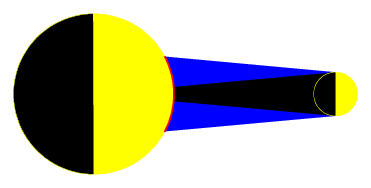
What is an eclipse? Simply put, eclipses occur when the Earth or the Moon fall within each others shadows, coming directly between each other and the Sun. They can be very dramatic – in ancient times,in fact, the Chinese said that an eclipse was caused by a celestial dragon which was devouring the Sun. Eclipses are some of the most fascinating examples of astronomical phenomena that we can experience, and many (the lunar eclipses) can be viewed safely with the naked eye, without the need for any specialized equipment.
There are two types of eclipses. The lunar eclipse is more common, and occurs when the shadow of the Earth obscures the Sun's light upon the full Moon. Over the course of an hour, one can observe the shadow slowly passing over the surface of the Moon, leaving darkness in its wake.
In the figure below, we see the positions of the small Moon (red and black) and the large Earth (yellow and black) during an evening lunar eclipse. The Sun is off to the right of our diagram, illuminating the yellow half of the Earth. The blue region indicates a partially illuminated area of space (less light than usual is received, but parts of the Sun still reach the sky). The black triangle indicates the area completely hidden behind the Earth, where no light falls. During an eclipse, the Moon passes within this triangular region.

Can you determine the phase of the Moon during a lunar eclipse? How much of it would appear illuminated from Earth, if the Earth's shadow did not intersect the exact path of the Moon? Now place yourself on the Moon, and figure out what phase the Earth would appear to have at the same time.
In our second figure, we see the positions of the small Moon (yellow and black) and the large Earth (yellow and black) during a noon day solar eclipse. The Sun is again set off to the right of our diagram, illuminating the yellow half of the Moon and most of the right hand (yellow) hemisphere of the Earth. The blue region indicates a partially illuminated area of space hidden (less light than usual is received, but parts of the Sun still reach the sky). The black triangle indicates the area completely hidden behind the Moon, where no light falls. During an eclipse, the a portion of the Earth passes within this triangular region.
